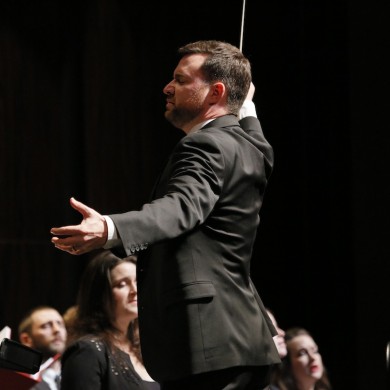Seraphic Fire rises magnificently to the challenge of Bach’s “St. Matthew Passion”
Johann Sebastian Bach’s St. Matthew Passion is one of the towering landmarks in music. Considering the many Bach liturgical scores and cantatas (including the Mass in B minor and the St. John Passion) Seraphic Fire has presented, it is difficult to believe that the choir had never before performed the work.
Before a full house Friday night at First United Methodist Church in Coral Gables, that omission was rectified in typically individual style.
With a characteristic adventurous spirit, artistic director Patrick Dupré Quigley offered a different edition of Bach’s setting of the trial and crucifixion of Jesus Christ than is usually heard. Most performances of the work largely adhere to Bach’s final revised score from 1736. Quigley went back to Bach’s first version from 1727, incorporating some of Felix Mendelssohn’s cuts and revisions from the historic revival that Mendelssohn conducted in 1829. The result was a streamlined hybrid that encompassed all of the most important arias and choruses but avoided that elongated aura that can overtake lengthier but less inspired performances.
Bach’s original conception involved a smaller group of performers and different distribution of vocal and instrumental parts. Quigley fielded a twenty-voice choir (including eight singers from Seraphic Fire’s Ensemble Arts Program at UCLA) and a twenty-piece orchestra. Per Bach’s original conception of double choir and instrumental ensemble, both singers and players were divided into two separate groups on opposite sides of the podium.
Instrumental textures emerged light and distinct with the wind lines especially transparent. Quigley blended the orchestral and choral forces skillfully. His moderate tempo in the great opening chorus allowed the music to work its deeply moving spell. Throughout the performance’s two-hour length, Quigley kept the drama taut and moving forward. He allowed his singers’ individual timbres to stand out while melding them into a vocally cohesive unit.
The many reflective chorales that provide commentary on the story benefited from Quigley’s supple play of dynamics and natural pacing. There was no romanticized exaggeration nor the overly brisk coldness favored by some period instrument leaders.
Quigley whipped up real fury at the shock of Judas’s betrayal in the chorus “Sind Blitze.” There was great expressive weight and force in the final chorus of Part I “O Mensch, bewein dein Sünde groB” (Oh mankind, mourn your great sin). Quigley maintained a flowing pulse and drew vocal and instrumental sonorities at this pivotal moment that seemed larger than the forces at hand. The evening culminated with “Wir setzen uns mit Tränen nieder” (We sit down with tears), shaped with unhurried breadth by Quigley and displaying the entire ensemble’s beautifully integrated warmth of expression. This was the pinnacle of a consistently engrossing and intense reading.
The pivotal role of the Evangelist who narrates the story was superbly sung by Steven Soph. His clean, musically scrupulous articulation of the secco recitative was finely modulated with subtle phrasing and dynamics, which were particularly powerful in the description of Jesus’s death.
Kenneth Kellogg brought dark, noble bass tones to Jesus’s pronouncements. His grave declamation predicting Peter’s denial was particularly effective, strongly buttressed by the “string halo” around Jesus’s words.
Among a constellation of Seraphic Fire’s best singers in the solo recitatives and arias, a new member stood out. Nola Richardson’s pure, vibratoless soprano brought dramatic expressivity to “Blute nuir, du liebes Herz” (Bleed on, dear heart) as well as fire in her description of the horrors of Golgotha. Amanda Crider’s “Erbarm es Gott” (Have mercy, God) was a striking cry of pain, rendered in her dusky mezzo timbre. Clara Osowski sang “Erbarme dich, mein Gott” (Have mercy, my God) with heartbreaking beauty, sustaining the long lines with a mezzo of depth and strength. Margot Rood’s beautifully modulated high soprano radiated a sense of darkness in “Aus liebe” (My Savior).
Doug Dodson’s distinctive countertenor had the agility and flexibility for the drama of the recitatives and the Baroque rhythmic thrust of the call for remorse and repentance. The excellent tenor Patrick Muehleise brought real musicality and finely executed coloratura runs to his solos. There was gravitas in Steven Eddy’s pliant baritone for the plaintive aria opening Part II. After some inaudibility in his initial solo, Charles Wesley Evans rose to a strong and voluminous “Mache dich, mein Herze, rein” (Make yourself pure, my heart), shaped spaciously by Quigley.
Organist Justin Blackwell and basses Lizzie Burns and Nathaniel Chase provided stalwart continuo in the recitatives. The orchestral ensemble was consistently alert and polished with special kudos to Matt Albert’s solo violin and the outstanding flutes and oboes, four each.
There is only one remaining performance in Fort Lauderdale tonight. Even among its outstanding efforts, this St. Matthew Passion rates as one of Seraphic Fire’s finest achievements.
Seraphic Fire repeats Bach’s St. Matthew Passion 7:30 p.m. Saturday at All Saints Episcopal Church in Fort Lauderdale. seraphicfire.org
Posted in Performances
Leave a Comment
Sat Feb 17, 2018
at 1:08 pm
No Comments







